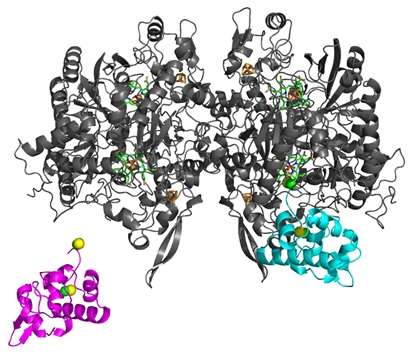Redox cycling by DsrC protein suggests reason for interaction with dissimilatory sulfite reductase

Scientists recently isolated and characterized oxidized and reduced forms of the protein DsrC, an important step toward understanding DsrC's critical role in sulfate respiration. DsrC is known to interact closely with the essential enzyme dissimilatory sulfite reductase, or DsrAB, which catalyzes the six electron reduction of sulfite to sulfide. Thus, DsrC operates within the metabolic process by which bacterially mediated sulfate reduction generates most of the biogenic sulfide—around one gigaton annually—in the global biogeochemical sulfur cycle.
Sulfate-reducing bacteria thrive in anoxic environments, such as marine and freshwater sediments, by respiring sulfate, rather than oxygen as they consume organic compounds. The product of this metabolism is hydrogen sulfide, a toxic gas with a characteristic rotten-egg smell.
The Impact
Understanding microbial sulfate respiration is important for understanding the global sulfur and carbon cycles and for quantifying carbon dioxide emissions from the biosphere. Sulfate-reducing bacteria are also the primary culprit in the development of troublesome microbial biofilms that can form on wetted ferrous metal surfaces, such as ship hulls, oil pipelines or in wastewater treatment plants. Such biofouling frequently leads to corrosion and failure of costly equipment and infrastructure. Understanding metabolism in sulfate-reducing bacteria and the role of these bacteria in biofilm communities will help researchers learn to deter biofouling and mitigate the corrosion associated with it, thereby saving governments and industry billions of dollars annually.
Summary
Scientist Inês A.C. Pereira and colleagues at the Universities of Lisbon, Portugal, and Bonn, Germany, developed a method to generate and assay the oxidized and reduced states of the of the protein DsrC from the archetypical sulfate-reducing bacterium, Desulfovibrio vulgaris. Collaborators at Pacific Northwest National Laboratory and EMSL used Fourier transform ion cyclotron resonance mass spectrometry and ion mobility spectrometry/time-of flight/mass spectrometry to characterize the two redox states of DsrC. First characterized structurally and functionally by EMSL scientists using nuclear magnetic resonance spectroscopy several years ago, DsrC is known to interact closely with the cytosolic enzyme dissimilatory sulfite reductase, or DsrAB. The authors also characterized the distribution of DsrC in cell extracts, finding that most was not bound to DsrAB and therefore free to possibly interact with other proteins. The current work supports a hypothesized mechanism through which DsrC may operate: electrons derived from growth on organic compounds are transferred to quinones in the cell membrane and from those to oxidized DsrC through its interaction with a membrane protein complex, DsrMKJOP. Next, this reduced DsrC delivers two electrons to the dissimilatory sulfite reductase enzyme, DsrAB, where they are transferred to sulfite to facilitate conversion to sulfide. After delivering these two electrons, DsrC has become oxidized and is probably bound to the product sulfide.
This DsrC persulfide could then detach from DsrAB, release sulfide for transport out of the cell by forming an intramolecular disulfide bond, and finally become reduced again by DsrMKJOP to complete the cycle. A detailed understanding of energy metabolism in D. vulgaris may enable development of methods to deter biofouling and the corrosion associated with it, and will help clarify the role and importance of sulfate-reducing bacteria in the biogeochemical sulfur and carbon cycles.
More information: Sofia S. Venceslau, John R. Cort, Erin S. Baker, Rosalie K. Chu, Errol W. Robinson, Christiane Dahl, Lígia M. Saraiva, and Inês A.C. Pereira. 2013. "Redox states of Desulfovibrio vulgaris DsrC, a key protein in dissimilatory sulfite reduction." Biochemical and Biophysical Research Communications. dx.doi.org/10.1016/j.bbrc.2013.10.116
Journal information: Biochemical and Biophysical Research Communications
Provided by Environmental Molecular Sciences Laboratory


















